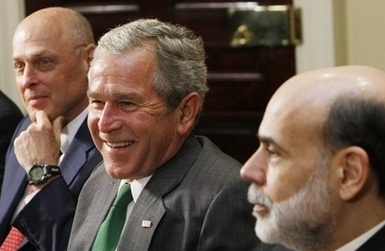Wall Street awaits government plan
(Agencies)
Updated: 2008-03-31 08:01
Updated: 2008-03-31 08:01
New York -- While Wall Street faces the biggest overhaul of its regulatory structure since the Great Depression, analysts are already wondering if the plan to be announced by US Treasury Secretary Henry Paulson on Monday would help prevent the kind of risky investments that led to the near-collapse of Bear Stearns Cos.
The plan maps out a course for broader oversight of the United States' financial markets by consolidating power into the Federal Reserve. It will eliminate overlapping state and federal regulators and give the central bank an expanded role in looking at the books of investment banks and brokerages.
|
|
What remains unclear is exactly how much the Fed would be able to control Wall Street's freewheeling investment banks -- the banks including Bear Stearns that have lost billions of dollars over the past six months from buying risky mortgage-backed securities. While the proposal will for the first time impose regulation of hedge funds and private equity firms, some say it is lacking the kind of muscle to curb the Street's appetite for risk.
"This is a good start for the basis of discussion," said Peter Morici, a business professor at the University of Maryland and former chief economist of the US Trade Commission. "But, this is bank reform written by an investment banker. ... There's nothing so far to improve the conduct of business on Wall Street to avoid another crisis."
Paulson, the former chairman of the investment bank Goldman Sachs Group Inc., wants to streamline the regulatory system through steps such as merging the Securities and Exchange Commission and the Commodity Futures Trading Commission and incorporating the functions of the Office of Thrift Supervision into the office of the Comptroller of the Currency. But while the regulatory structure would be overhauled, there is little detail about how much actual power the Fed would have to force investment banks out of risky positions and prevent financial companies from failing.
The investment banks have been criticized not only for investing in risky mortgage-backed assets -- including loans to people with poor credit -- they've also been reproached for dealing in complex and often speculative products like structured investment vehicles and collateralized debt obligations.
"I think it is important to look at the Paulson plan as the beginning of the discussion, not necessarily its end," said Harvey Pitt, a former chairman of the Securities and Exchange Commission. "The critical ingredient in any plan, however, is total transparency, something that was sorely lacking in our markets and caused the current crisis."
The plan, already backed by several financial industry trade organizations, would give the Fed some say over how much liquidity and capital that investment banks have on their books. But, as currently presented, action would be limited to instances "where overall financial market stability was threatened," according to a 22-page executive summary of the proposal obtained by The Associated Press.
While Paulson's proposal looks to shore up the nation's financial industry, it will also try to avoid putting investment banks at a competitive disadvantage with overseas investment firms. Still, analysts noted, this is an election year, and therefore Wall Street can expect to see regulation it hasn't had to comply with in the past.
Richard X. Bove, a bank analyst at Punk Ziegler & Co., questioned whether investment banks being forced to maintain more capital and higher reserves would limit their attempts to achieve high returns. Wall Street firms, unlike more regulated commercial banks, tend to use large amounts of leverage, or borrowed money, to magnify profit margins; while higher capital requirements would stem losses during economic downturns, they would also prevent investment banks from making the kind of profits they did during the recent bull run.
But ultimately, Bove said, Wall Street put itself in the position it now finds itself in.
"The financial industry blew it, did not exercise any restraint, and now the financial system is at risk," he said. "It is evident that there must be some kind of re-regulation."
|
||
|
||
|
|
|
|
